Growing Tomatoes in grow bags offer several advantages. They are portable, allowing you to move them around your patio or yard to find the best sunlight. Grow bags also provide excellent drainage and aeration for healthy root growth. Plus, they are reusable and require less water than traditional gardening methods.
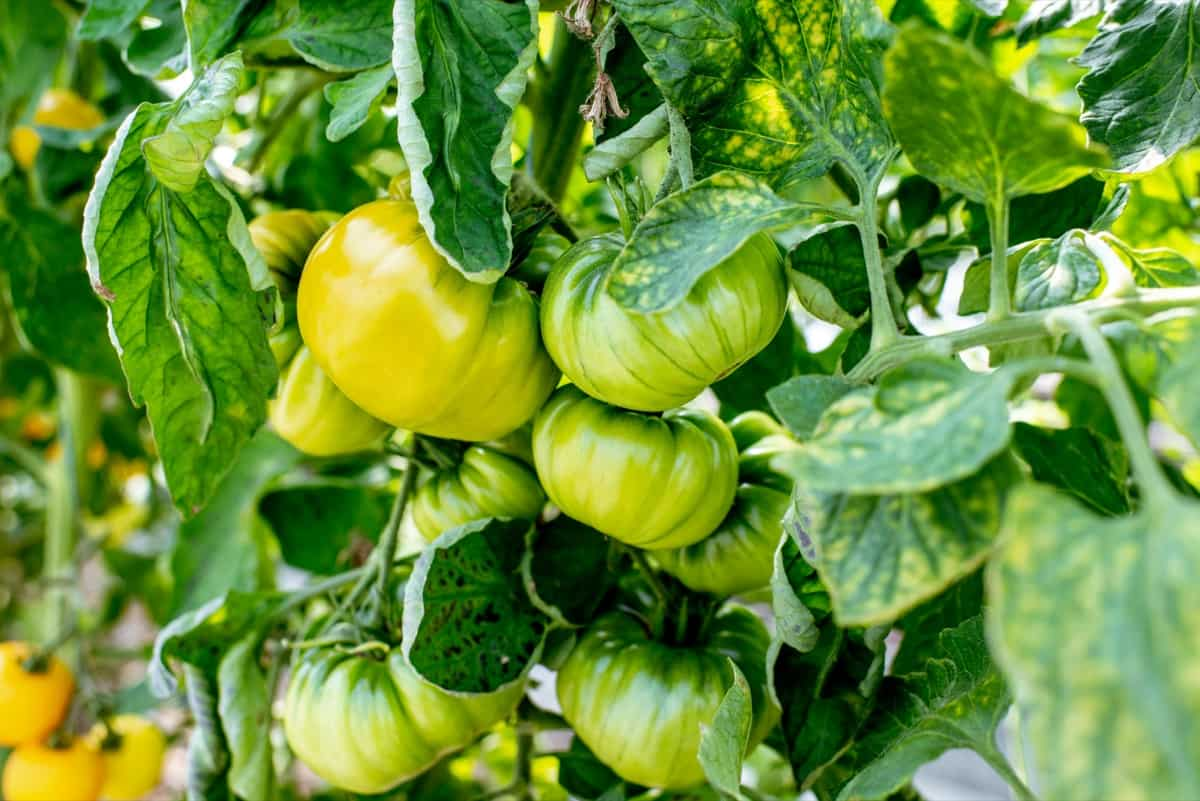
If you’re a seasoned gardener or just starting, growing Tomatoes in grow bags offers flexibility, convenience, and great results. Experiment with different varieties of Tomatoes to discover which ones work best for you, and enjoy the satisfaction of picking juicy red fruits straight off the vine.
How to Grow Tomatoes in Grow Bags
Choosing the Right Grow Bags for Tomatoes
Choosing the right Tomato grow bags is crucial in ensuring a successful harvest. With so many options available, deciding which is best suited for your needs can be overwhelming. If you’re feeling crafty and want to save money, why not make your Tomato grow bags? It’s a fun project that allows you to customize the size and style of your bags. Size matters when selecting grow bags for Tomatoes.
Ideally, you should choose bags that are at least 5 gallons in capacity. This provides enough space for the Tomato roots to grow and allows for proper drainage. Growing Tomatoes in cloth or fabric bags is a great option for gardeners looking for an alternative to traditional planting methods. Cloth bags provide excellent drainage and allow the roots of the Tomato plants to breathe, resulting in healthier and more productive plants.
Another factor to consider is whether the grow bag has handles. Handles make it easier to move the bags around as needed and provide convenience during planting and harvesting. You can also reuse grow bags for Tomatoes. Furthermore, consider if the grow bag has reinforced bottoms or side gussets.
Preparing Grow Bags for Tomato Planting
Choosing the right grow bags is crucial for successful Tomato cultivation. Consider their material, size, and drainage capabilities when selecting grow bags. Fabric or cloth grow bags are popular as they provide excellent aeration and drainage while preventing root circling. Before planting Tomatoes in grow bags, it’s important to prepare them properly. Clean the grow bags with water and mild soap to remove dirt or residue.
In case you missed it: 14 Common Problems with Cherry Tomato Plants: Prevention, Treatment, and Solutions
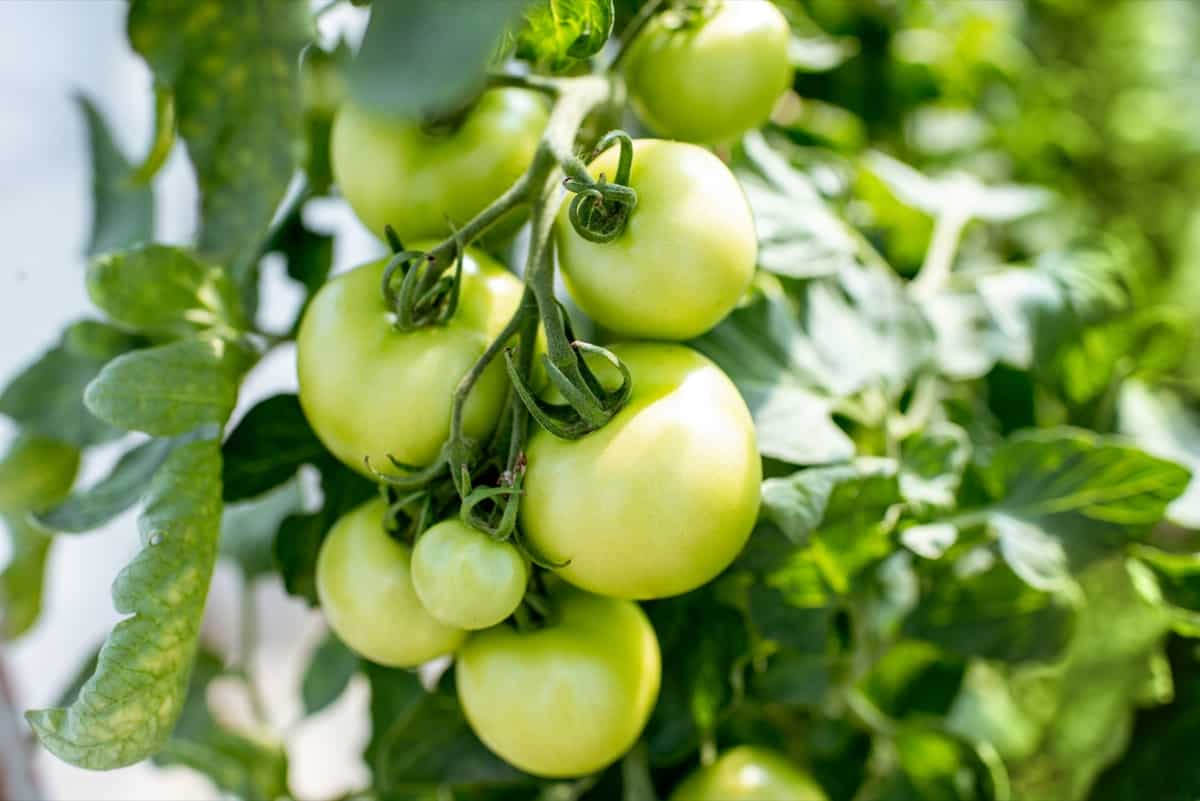
Next, fill the grow bag with high-quality potting soil mixed with compost or organic matter. This will provide essential nutrients and ensure good drainage. To further enhance drainage, create small holes at the bottom of the grow bag. These holes will prevent water pooling at the bottom and causing root rot. Once filled with soil, place the prepared grow bags in a suitable location that receives at least six hours of direct sunlight daily. Position them on raised platforms or stands to improve air circulation around the plants.
Planting Tomato Seeds in Grow Bags
Once you have chosen the right grow bags for your Tomatoes and prepared them, it’s time to think about when to plant Tomatoes in grow bags. Start by filling the grow bags with a high-quality potting mix designed for vegetables. The best way to plant Tomatoes in grow bags, make small holes on the surface of the soil, about half an inch deep. Place one or two Tomato seeds in each hole and cover them lightly with soil.
Be sure to space out the holes adequately to give each seedling enough room to grow. How many Tomato plants can you grow in a grow bag? It’s a common question among gardeners looking to maximize their space and yield. The answer depends on the size of the grow bag and the type of Tomato plant you’re growing.
One common question when growing Tomatoes in grow bags is how many Tomato plants can be planted in a 5-gallon grow bag? Well, the answer depends on several factors. For a 5-gallon grow bag, it is recommended to plant one indeterminate Tomato plant or two determinate Tomato plants. A 10-gallon grow bag is popular among gardeners because it provides ample space for Tomato plants to thrive. But how many Tomato plants can you grow in a 10-gallon bag?
The answer depends on various factors such as the type of Tomato plant, its growth habit, and your preferences. After planting, water gently using a mist sprayer. Avoid overwatering, as this can lead to the rotting of the seeds. Place the grow bags in a sunny location where they get at least 6-8 hours of direct sunlight daily.
Tomatoes thrive in warm temperatures between 21-27°C. Keep an eye on moisture levels in the grow bag and ensure it remains consistently moist but not waterlogged. Water whenever needed, usually every few days, depending on weather conditions. As soon as you see tiny green shoots emerging from the soil. Your Tomato seedlings have started germinating. At this stage, ensure they receive adequate sunlight and maintain proper watering habits.
In case you missed it: Expert Tips to Grow the Tastiest Tomatoes: DIY Guide

Transplanting Tomato Seedlings into Grow Bags
Once your Tomato seedlings have reached a height of around six to eight inches and developed their second set of true leaves, it’s time to transplant them into grow bags. Transplanting is an important step in the growth process as it allows the seedlings more space and nutrients to thrive. Before you begin, make sure you have chosen the right size grow bag for your Tomatoes.
Start by filling each grow bag with a well-draining potting mix to transplant. Create a small hole in the center of each bag, deep enough to hold the roots of your seedling without crowding them. Gently remove each seedling from its original container, carefully not damaging the delicate roots. Place each seedling into its designated hole and lightly firm the soil around it, ensuring no air pockets are left behind. Water thoroughly after transplantation to help settle the soil and promote root establishment.
Proper spacing between plants is crucial for adequate airflow and disease prevention. Aim for at least two feet between each plant when using grow bags. To give your transplanted Tomatoes their best chance at success, provide them with plenty of sunlight (at least six hours per day) and regular watering sessions as needed based on weather conditions. Monitor their progress closely over time, making adjustments if necessary.
Watering Tomatoes in Grow Bags
Proper watering is crucial for the healthy growth of Tomatoes in grow bags. Since grow bags have limited space, providing adequate moisture without overwatering is essential. So, how often should you water your Tomato plants in grow bags? The watering frequency depends on several factors, such as weather conditions, the size of the grow bag, and the stage of plant growth.
As a general rule, Tomatoes require consistent moisture but not soggy soil. Overwatering causes root rot and other diseases. To determine when your Tomatoes need watering, check the top inch of the soil. Avoid waiting until the plants are visibly wilting, as this can stress them out. An effective way to water Tomatoes in grow bags is through drip irrigation or a soaker hose system placed on top of the bag surface. This allows for slow and steady watering directly at the roots, preventing excess moisture on foliage.
During hot weather or if your grow bags are exposed to direct sunlight, you may need to water more frequently as evaporation rates increase. Remember that different Tomato varieties have varying water needs, so monitor each plant individually rather than applying a one-size-fits-all approach. Proper watering techniques ensure healthy growth and abundant harvests for Tomatoes grown in grow bags. Consistency and monitoring of individual plant needs are key factors for success.
In case you missed it: How to Control Pests and Diseases in Tomato Crop: Causes, Symptoms, Chemical, and Biological Management
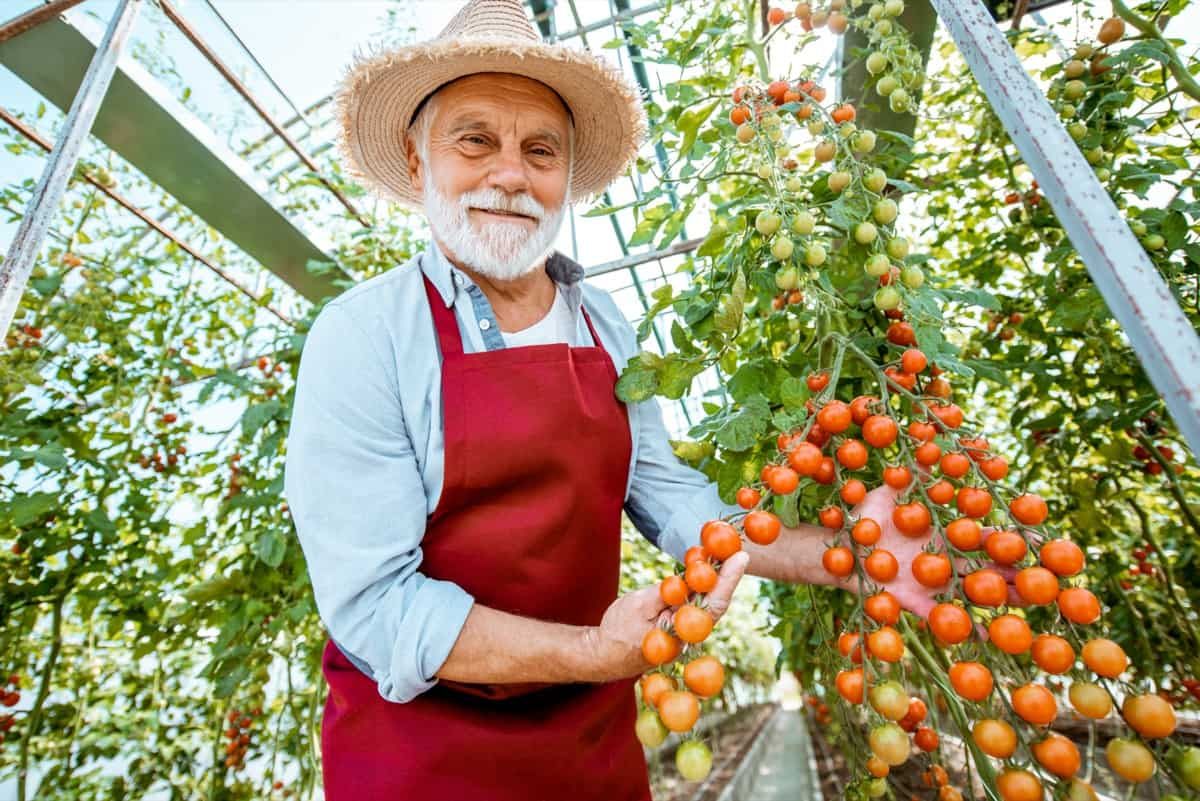
Fertilizing Tomatoes in Grow Bags
Fertilizing Tomatoes in grow bags is crucial for promoting healthy growth and maximizing the yield of your plants. Organic fertilizers provide a slow-release nutrient source that nourishes the soil over time. Simply sprinkle them on the grow bag soil and gently mix them in. On the other hand, synthetic fertilizers offer more precise control over nutrient levels. Look for balanced formulas for Tomatoes with an NPK ratio (nitrogen-phosphorus-potassium), like 10-10-10 or 14-14-14.
Follow the manufacturer’s instructions when applying these fertilizers to avoid overfeeding your plants. Remember that Tomato plants have different nutritional needs at each growth cycle stage. Start by applying a balanced fertilizer when transplanting seedlings into grow bags, then gradually increase feeding as they mature. Regularly monitor your plants’ leaves for any signs of nutrient deficiencies or excesses. Adjust your fertilizer application to maintain optimal plant health throughout the growing season.
Managing Pests and Diseases in Tomatoes Grown in Grow Bags
One common pest that affects Tomatoes is aphids. These insects suck the sap from the Tomato leaves, turn the leaves yellow, and wilt. You can control aphids by introducing beneficial insects like ladybugs or lacewings that feed on aphids. Another pesky critter that loves Tomatoes is the Tomato hornworm. These large caterpillars can quickly defoliate your plants if left unchecked. Handpicking them off your plants is an effective control method, but you can also use organic sprays containing Bacillus thuringiensis (BT) to target these destructive pests.
Diseases like fungal infections are another challenge faced by Tomato growers. One common disease is early blight, which causes dark spots on leaves and stems. To prevent early blight, avoid overhead watering and provide adequate spacing between plants for good air circulation. Late blight is another devastating disease that affects Tomatoes grown in humid conditions. This fungal infection causes brown lesions on leaves and fruits.
Preventive measures include removing infected plant parts immediately to prevent further spread of the disease. Practicing good sanitation techniques like cleaning up fallen debris around your grow bags regularly can reduce the risk of disease transmission among plants. Remember always to choose resistant varieties when selecting Tomato seeds for planting in grow bags, as this will greatly reduce the likelihood of encountering certain pests or diseases.
Pruning and Training Tomatoes in Grow Bags
One important aspect of growing Tomatoes in grow bags is pruning and training the plants. Pruning promotes better air circulation, reduces disease risk, and increases fruit production. When it comes to training, there are several methods you can use. Determine whether you want to grow your Tomatoes as indeterminate or determinate varieties. Indeterminate Tomatoes will continue growing throughout the season, requiring more extensive pruning and training.
In case you missed it: How to Grow Tomato Plants Faster: Best Tips to Increase Flowering, Fruiting, and Production Yield
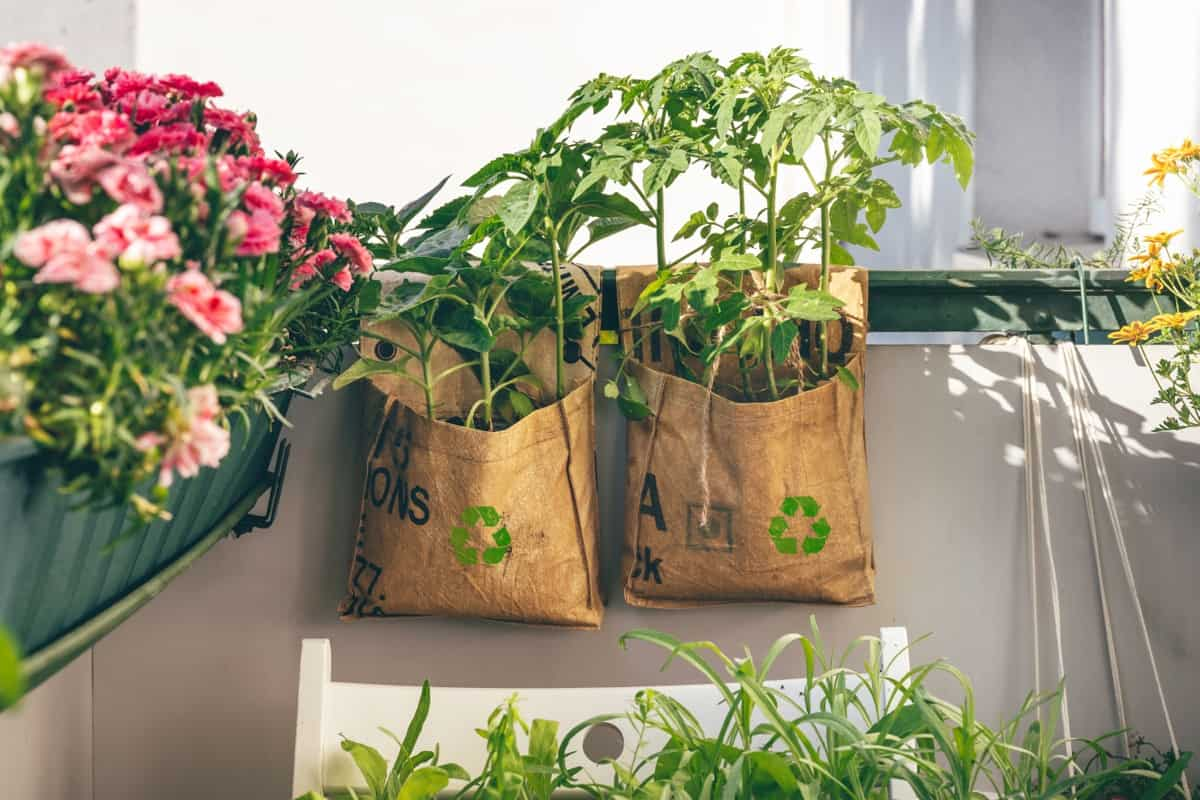
Determinate varieties have a more compact growth habit and need less pruning. Supporting Tomato plants in grow bags is essential for their growth and productivity. When growing cherry Tomatoes in grow bags, consider using stakes or cages to ensure they receive adequate support as they grow. This will help prevent sprawling vines and keep your plant upright and tidy.
To prune your Tomato plants effectively, start by removing any suckers that emerge from the leaf axils below the first flower cluster. This helps redirect energy toward fruit production rather than excessive foliage growth. Gently tie the main stem of each plant to its support structure using soft twine or fabric ties. As the plant grows taller, continue securing it regularly along the stake or trellis.
Regularly check for additional suckers that may develop on mature stems and remove them promptly. This will prevent overcrowding of branches which can lead to reduced airflow and increased disease susceptibility. Properly pruning and training your Tomato plants in grow bags can maximize their productivity while maintaining a healthy garden environment.
Harvesting Tomatoes Grown in Grow Bags
Once your Tomatoes have ripened to a beautiful shade of red (or whichever color they are supposed to be), it’s time to harvest them and savor the delicious taste of homegrown goodness. Harvesting Tomatoes grown in grow bags is a rewarding experience that allows you to enjoy the fruits of your labor. To start, gently squeeze the Tomato and give it a little twist.
If it comes off easily from the stem without any resistance, it’s ready to be picked. Be careful not to pull too hard, or you might damage the plant. It’s important to carefully handle the Tomatoes when harvesting, as they can bruise easily. Use two hands when picking them, supporting the fruit and the stem. It’s best to harvest Tomatoes in small batches rather than waiting for all of them to ripen at once.
This way, you can enjoy fresh Tomatoes throughout their growing season instead of being overwhelmed by a sudden abundance. Remember that not all Tomatoes will ripen simultaneously, so keep an eye on each plant and pick them as soon as they reach their desired level of ripeness. Some may take longer depending on factors such as variety and growing conditions.
In case you missed it: Why are my Tomatoes Rotting on the Bottom and Top: Blossom End Rot, Symptoms, Remedies, and Solutions
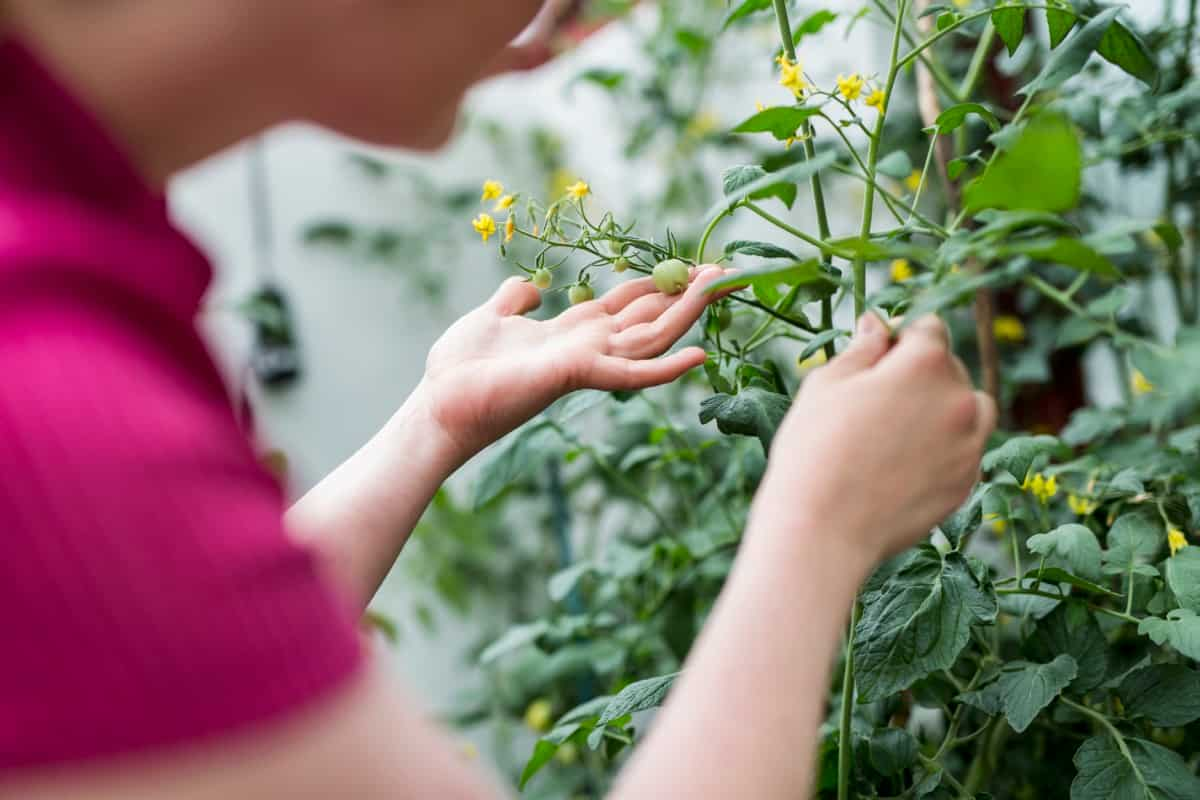
Conclusion
Growing Tomatoes in grow bags can be a rewarding and efficient way to cultivate these delicious fruits. You can enjoy juicy Tomatoes by choosing the right size and type of grow bag, preparing them properly, and providing appropriate care throughout the growing season. Remember to choose the right size and material of grow bag for your Tomatoes. When planting your Tomatoes in grow bags, start with healthy seedlings or sow seeds directly into the bag.
Provide proper support and regular watering to promote sturdy growth. Throughout the growing season, pay attention to essential care tips like providing adequate sunlight, fertilizing appropriately, pruning when necessary, and monitoring pests and diseases. Considering these steps when growing Tomatoes in grow bags, you will be well on your way to a bountiful harvest of delicious homegrown Tomatoes.
- Broccoli Seed Germination and Selection
- Asparagus Seed Germination and Variety Selection
- Seasonal Flower Gardening: Best Practices for Spring, Summer, Fall, and Winter
- How to Grow Hibiscus from Flower
- Plantation Ideas for Home Decoration: A Beginners Guide
- Flower Garden Designs and Layouts for Beginners
- Planting and Spacing Techniques in Papaya: A Beginner’s Guide
- Growing Gold: Essential Techniques for Planting Pineapples
- How to Make Kalanchoe Plant Bushy: Home Remedies and Solutions
- 11 Reasons Why Your Gardenia is Not Blooming: Home Remedies and Solutions
- Eco Elegance: The Guide to Designing a Drought-Tolerant Landscape
- Gardening on a Slope: Strategies for Hillside Landscaping
- Nourish and Flourish: Top Organic Mulches for Thriving House Plants
- Everything You Want to Know about Indian Mogra Flower: Discover Uses and Growing
- Green Thumb Success: Expert Tips for Cultivating Greenhouse Pumpkins All Year Round
- Maximize Growth & Flavor: The Ultimate Guide to Companion Planting in Herb Gardens
- How to Control Rhododendron Problems Naturally: Home Remedies and Organic Ways to Fix Them
- Natural Magic: The Remarkable Benefits of Cinnamon for Plants
- Best Steps to Revive Dying Tulip with Natural and Organic Treatment
- 10 Reasons Why Your Angel Trumpet is Not Blooming: Remedies and Treatment
- How to Fix Periwinkle Leaf and Flower-Related Problems: Natural Remedies and Solutions
- How to Fix Zinnias Leaf and Flower Problems: Discover Natural and Home Remedies
- Organic Steps to Induce Lemon Tree Flowers: A Comprehensive Guide
- Bloom Booster: Crafting the Perfect Homemade Bougainvillea Fertilizer
- Optimizing Growth: A Guide to Applying NPK Fertilizer for Potted Plants
- 10 Best Homemade Fertilizers for Rubber Plant: DIY Recipes and Application Method
- How to Boost Female Pumpkin Flowers: Effective Steps for More Flowers and High Yields
- Transform Your Indoor Garden: Top Benefits of Pink Salt for Houseplants
- 10 Best Homemade Fertilizers for Peacock Plants (Calathea): Easy DIY Guide
- Unlock Blooms: 9 Reasons Why Your Potted Chrysanthemum is Not Blooming
- 8 Reasons Why Your Potted Hibiscus is Not Blooming: Fix it with Simple Solutions
- Unlock Blooms: 9 Key Reasons Your Potted Frangipani Won’t Flower
- 10 Reasons Why Is My Ice Plant Not Blooming: Remedies and Treatment
- 10 Reasons Why My Potted Hydrangea Not Blooming: Treatment and Remedies
- 10 Reasons Why is My Wisteria Not Blooming: Remedies and Treatment
- 10 Reasons Why is My Goldfish Plant Not Blooming: Remedies and Treatment